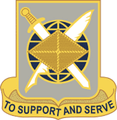U.S. Army Regimental System
The United States Army Regimental System (USARS) was established in 1981 to replace the Combat Arms Regimental System, to provide each Soldier with continuous identification with a single regiment, and to support that concept with a personnel system that would increase a soldier’s probability of serving recurring assignments with his or her regiment. The USARS was developed with the intention that it would enhance combat effectiveness by providing the opportunity for a regimental affiliation, thus obtaining some of the benefits of the traditional regimental system.
Overview
USARS was developed to include the Active Army (all Combat Arms battalions, separate companies, batteries, and troops; all Combat Support (CS), Combat Service Support (CSS), and Special Branches, and appropriate Training Base battalions) and the Reserve Components (the Army National Guard and the Army Reserve).
It was developed to offer the opportunity for long-term identification with a regiment or corps, provide the potential for recurring assignments within a regiment or corps, provide the opportunity to further emphasize the history, customs, and traditions of the regiment or corps, and provide regiments that are structured as one or more Continental United States (CONUS) units of like type linked with one or more units of like type Outside the Continental United States (OCONUS), or one or more units of like type located exclusively in either CONUS or OCONUS, including one or more training battalions and/or tactical armored cavalry or ranger regiments.
USARS is also designed to provide for CS, CSS, and special branches to operate on a “whole branch” concept as a corps or special branch, carrying on the activities and traditions of a regiment, offer regimental affiliation to allow soldiers the opportunity for continuous identification with a combat arms regiment, a corps, or special branch throughout their careers. USARS Provides (through regimental affiliation) different opportunities for Soldiers, depending upon which combat arms regiment they choose to be affiliated with or whether they affiliate with a CS or CSS corps or special branch. In addition, the regimental affiliation process allows combat arms soldiers to select the regiment of choice (soldiers can change their affiliation at any time); provides that CS, CSS, and special branch soldiers will automatically be affiliated with their corps or special branch; specifies that all soldiers will belong to a regiment or corps; permits no limit to the number of Soldiers who can be affiliated with a regiment or corps; and provides that DA civilians can automatically be affiliated with a regiment or corps by direction of the regiment or corps commander.
Combat Arms
Concept
Combat arms is a rescinded doctrinal term, though colloquially it includes air defense artillery, armor, aviation, field artillery, infantry, and special forces regiments. Combat arms soldiers may affiliate with any of the combat arms regiments consistent with their primary military occupational specialty (PMOS), specialty code, special qualification identifiers (SQI), or additional skill identifiers (ASI). It should be noted that soldiers will have greater opportunities to serve recurring assignments in their regiments if regiments are chosen that have battalions in both CONUS and OCONUS locations. Since there is no ceiling on the number of soldiers who can affiliate with a particular regiment, the potential for recurring assignments to regiments is diminished where the number of affiliated soldiers exceeds the requirements.
Affiliation policy
Quoting from Chapter 3–2, page 7 of Army Regulation 600-82, U.S. Army Regimental System (note: Army Regulation 600-82 has been superseded by Army Regulation 670-1):
a. USARS regiments offered to Active Army and USAR soldiers for affiliation are listed [below].
- (1) All active Army soldiers are required to affiliate with a regiment. Although affiliation is mandatory, the choice of regiment is left up to the individual. Officers who are single-tracked in a Functional Area will affiliate with a regiment associated with their basic combat arms branch. Functional Area officers who have no basic branch will submit request for regimental affiliation using procedures outlined below. Regimental affiliation is based on the Army branch associated with a soldier’s PMOS or specialty. AR 670–1 contains a listing of all PMOS and corresponding branches for each. Army recruiters who have been assigned the SQI“4” will affiliate with a regiment associated with their PMOS. Recruiters or retention noncommissioned officers (NCOs) will be affiliated with The Adjutant General Corps. Regimental affiliation may be changed at any time; however, the regimental selection must be associated with the soldier’s PMOS or specialty.
- (2) All combat arms officers and soldiers will affiliate with a regiment upon arrival at their first unit of assignment. These Soldiers will be affiliated with their regiment of assignment unless they voluntarily select another. Combat arms officers and soldiers whose initial Army assignment is not to a regimental unit may defer selection until they are so assigned.
- (3) Enlisted soldiers may elect the Regiment of Choice Reenlistment Option under AR 601–280.
- (4) Soldiers who deliberately terminate airborne status after affiliating with an airborne regiment will change their affiliation to a non-airborne regiment at the time of their termination. Those who are terminated for medical reasons may retain their regimental affiliation with an airborne regiment if they desire; however, such affiliation will be ceremonial and will not affect subsequent assignments.
- (5) Regimental affiliation will be a primary assignment consideration for officers and enlisted soldiers. To the maximum extent possible, soldiers who are regimentally affiliated will be assigned to their regimental units. No assignment guarantees will be made, as Army requirements and soldier professional development needs must be met; however, it is incumbent upon commanders and the personnel community to make every effort to ensure that requisitions are submitted for and filled with affiliated regimental Soldiers and that soldiers are subsequently assigned within their regiments. (See AR 614–100, and AR 614–185 for officers, and AR 614–200 for enlisted soldiers).
b. Specific procedures for affiliation are below. These procedures permit affiliation and change of affiliation to be administered at the local Personnel Service Center (PSC) level.
c. Active Army soldiers who are accessioned into the USAR will retain their regimental affiliation unless they elect to change their affiliation, which may be done at any time.
Combat Arms Regiments
Note: The U.S. Army is currently going through a major reorganization, units are being "Re-Flagged" or "Re-designated" as needed. There are currently 177 Regiments, only 47 consist of units at multiple locations, 27 of which meet the "Conus/Oconus goal." The majority of Regiments have only one Company or Battalion in existence.
Artillery Regiments
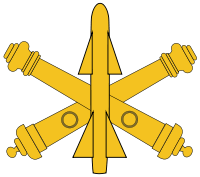 Air Defense Artillery
Air Defense Artillery
 1st Air Defense Artillery Regiment
1st Air Defense Artillery Regiment
- 1st Battalion, 94th AAMDC, Kadena Air Base Japan
- 2nd Battalion, 35th Air Defense Artillery Brigade, Osan Air Base, Korea
 2d Air Defense Artillery Regiment
2d Air Defense Artillery Regiment
- Battery A, 11th Air Defense Artillery Brigade, Fort Bliss, Texas
- 3d Battalion, 31st Air Defense Artillery Brigade, Fort Sill, Oklahoma
 3rd Air Defense Artillery Regiment
3rd Air Defense Artillery Regiment
- 4th Battalion, 31st Air Defense Artillery Brigade, Fort Sill, Oklahoma
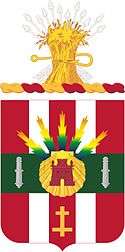 4th Air Defense Artillery Regiment
4th Air Defense Artillery Regiment
- Battery A, 11th Air Defense Artillery Brigade, Fort Bliss, Texas
- 3d Battalion, 108th Air Defense Artillery Brigade, Fort Bragg, North Carolina
 5th Air Defense Artillery Regiment
5th Air Defense Artillery Regiment
- 4th Battalion, 69th Air Defense Artillery Brigade, Fort Hood, Texas
- 5th Battalion, 31st Air Defense Artillery Brigade, Fort Sill, Oklahoma
- 6th Air Defense Artillery Regiment (Training Regiment)
- 2d Battalion, 30th Air Defense Artillery Brigade, Fort Sill, Oklahoma
- 3d Battalion, 30th Air Defense Artillery Brigade, Fort Sill, Oklahoma
 7th Air Defense Artillery Regiment
7th Air Defense Artillery Regiment
- 1st Battalion, 108th Air Defense Artillery Brigade, Fort Bragg, North Carolina
- 5th Battalion, 10th Army Air & Missile Defense Command, Germany
 43d Air Defense Artillery Regiment
43d Air Defense Artillery Regiment
- 1st Battalion, 11th Air Defense Artillery Brigade, Fort Bliss, Texas
- 2d Battalion, 11th Air Defense Artillery Brigade, Fort Bliss, Texas
- 3d Battalion, 11th Air Defense Artillery Brigade, Fort Bliss, Texas
 44th Air Defense Artillery Regiment
44th Air Defense Artillery Regiment
- 1st Battalion, 69th Air Defense Artillery Brigade, Fort Hood, Texas
- 2d Battalion, 108th Air Defense Artillery Brigade, Fort Campbell, Kentucky
 52d Air Defense Artillery Regiment
52d Air Defense Artillery Regiment
- 5th Battalion, 11th Air Defense Artillery Brigade, Fort Bliss, Texas
- 6th Battalion, 35th Air Defense Artillery Brigade, Osan Air Base, Korea
 56th Air Defense Artillery Regiment
56th Air Defense Artillery Regiment 62nd Air Defense Artillery Regiment
62nd Air Defense Artillery Regiment
- 1st Battalion, 69th Air Defense Artillery Brigade, Fort Hood, Texas
 Field Artillery
Field Artillery
-
 1st Field Artillery Regiment
1st Field Artillery Regiment
- 4th Battalion, 3d BCT, 1st Armored Division, Fort Bliss, Texas
-
 2d Field Artillery Regiment
2d Field Artillery Regiment
- 2nd Battalion, 428th Field Artillery Brigade, Fort Sill, Oklahoma
-
 3d Field Artillery Regiment
3d Field Artillery Regiment
- 2d Battalion, 1st BCT (Stryker), 1st Armored Division, Fort Bliss, Texas
- 5th Battalion, 17th Fires Brigade, I Corps, Fort Lewis, Washington
-
 4th Field Artillery Regiment
4th Field Artillery Regiment
-
 5th Field Artillery Regiment
5th Field Artillery Regiment
- 1st Battalion, 1st BCT, 1st Infantry Division, Fort Riley, Kansas
-
 6th Field Artillery Regiment
6th Field Artillery Regiment
- 1st Battalion, 3d BCT, 1st Infantry Division, Fort Hood, Texas
- 3d Battalion, 1st BCT, 10th Mountain Division (Light Infantry), Fort Drum, New York
-
 7th Field Artillery Regiment
7th Field Artillery Regiment
- 1st Battalion, 2d BCT, 1st Infantry Division, Fort Riley, Kansas
- 3d Battalion, 3d BCT, 25th Infantry Division, Schofield Barracks, Hawaii
-
 8th Field Artillery Regiment
8th Field Artillery Regiment
- 2d Battalion, 1st BCT, 25th Infantry Division, Fort Wainwright, Alaska
-
 9th Field Artillery Regiment
9th Field Artillery Regiment
- 1st Battalion, 2d BCT, 3d Infantry Division, Fort Stewart, Georgia
-
 10th Field Artillery Regiment
10th Field Artillery Regiment
- 1st Battalion, 3d BCT, 3d Infantry Division, Fort Benning, Georgia
-
 11th Field Artillery Regiment
11th Field Artillery Regiment
- 2d Battalion, 2d BCT, 25th Infantry Division, Schofield Barracks, Hawaii
-
 12th Field Artillery Regiment
12th Field Artillery Regiment
- 2d Battalion, 1st BCT, 4th Infantry Division, Fort Carson, Colorado
-
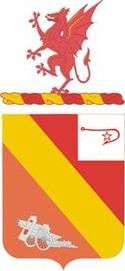 13th Field Artillery Regiment
13th Field Artillery Regiment
- 3d Battalion, 75th Fires Brigade, Fort Sill, Oklahoma
-
 14th Field Artillery Regiment
14th Field Artillery Regiment
-
 15th Field Artillery Regiment
15th Field Artillery Regiment
- 1st Battalion, 1st BCT, 2d Infantry Division, South Korea
- 2d Battalion, 2d BCT, 10th Mountain Division (Light Infantry), Fort Drum, New York
-
 16th Field Artillery Regiment
16th Field Artillery Regiment
- 3d Battalion, 2d BCT, 4th Infantry Division, Fort Carson, Colorado
-
 17th Field Artillery Regiment
17th Field Artillery Regiment
- 1st Battalion, 75th Fires Brigade, Fort Sill, Oklahoma
- 3d Battalion, 2d BCT, 2d Infantry Division, Fort Lewis, Washington
-
 18th Field Artillery Regiment
18th Field Artillery Regiment
- 2d Battalion, 75th Fires Brigade, Fort Sill, Oklahoma
-
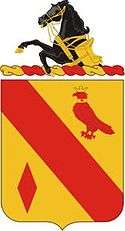 19th Field Artillery Regiment
19th Field Artillery Regiment
- 1st Battalion, 434th Field Artillery Brigade, Fort Sill, Oklahoma
- 20th Field Artillery Regiment
- 2d Battalion, 41st Fires Brigade, Fort Hood, Texas
-
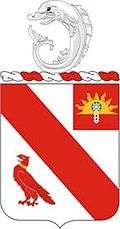 21st Field Artillery Regiment
21st Field Artillery Regiment
- 1st Battalion, 41st Fires Brigade, Fort Hood, Texas
-
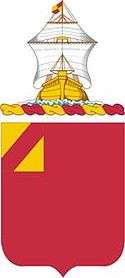 22d Field Artillery Regiment
22d Field Artillery Regiment
- 1st Battalion, 434th Field Artillery Brigade, Fort Sill, Oklahoma
-
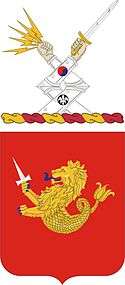 25th Field Artillery Regiment
25th Field Artillery Regiment
- 4th Battalion, 3d BCT, 10th Mountain Division (Light Infantry), Fort Drum, New York
- 5th Battalion, 4th BCT, 10th Mountain Division (Light Infantry), Fort Polk, Louisiana
-
 26th Field Artillery Regiment
26th Field Artillery Regiment
- Battery A (Target Acquisition), 41st Fires Brigade, III Corps, Fort Hood, Texas
- Battery B (Target Acquisition), 212th Fires Brigade, III Corps, Fort Bliss, Texas
- Battery C (Target Acquisition), 75th Fires Brigade, III Corps, Fort Sill, Oklahoma
- Battery D (Target Acquisition), 18th Fires Brigade, XVIII Airborne Corps, Fort Bragg, North Carolina
- Battery F (Target Acquisition), 17th Fires Brigade, I Corps, Fort Lewis, Washington
-
 27th Field Artillery Regiment
27th Field Artillery Regiment
- 3d Battalion, 18th Fires Brigade, XVIII Airborne Corps, Fort Bragg, North Carolina
- 4th Battalion, 2d BCT, 1st Armored Division, Fort Bliss, Texas
-
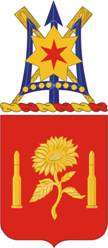 29th Field Artillery Regiment
29th Field Artillery Regiment
- 2d Battalion, 4th BCT, 1st Armored Division, Fort Bliss, Texas
- 3d Battalion, 3d BCT, 4th Infantry Division, Fort Carson, Colorado
- 30th Field Artillery Regiment
- 1st Battalion, 428th Field Artillery Brigade, Fort Sill, Oklahoma
-
 32d Field Artillery Regiment
32d Field Artillery Regiment
- 2d Battalion, 4th BCT, 1st Infantry Division, Fort Riley, Kansas
-
 37th Field Artillery Regiment
37th Field Artillery Regiment
- 1st Battalion, 3d BCT (Styker), 2d Infantry Division, Fort Lewis, Washington
- 6th Battalion, 210th Fires Brigade, 2d Infantry Division, South Korea
-
 38th Field Artillery Regiment
38th Field Artillery Regiment
- 1st Battalion, 210th Fires Brigade, 2d Infantry Division, South Korea
-
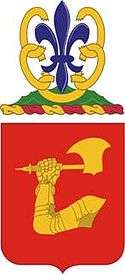 40th Field Artillery Regiment
40th Field Artillery Regiment
- 1st Battalion, 434th Field Artillery Brigade, Fort Sill, Oklahoma
-
 41st Field Artillery Regiment
41st Field Artillery Regiment
- 1st Battalion, 1st BCT, 3d Infantry Division, Fort Stewart, Georgia
-
 42d Field Artillery Regiment
42d Field Artillery Regiment
- 4th Battalion, 1st BCT, 4th Infantry Division, Carson, Colorado
-
 76th Field Artillery Regiment
76th Field Artillery Regiment
- 1st Battalion, 4th BCT, 3d Infantry Division, Fort Stewart, Georgia
-
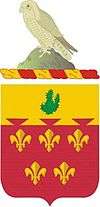 77th Field Artillery Regiment
77th Field Artillery Regiment
- 2d Battalion, 4th BCT, 4th Infantry Division, Fort Carson, Colorado
-
 78th Field Artillery Regiment
78th Field Artillery Regiment
- 1st Battalion, 428th Field Artillery Brigade, Fort Sill, Oklahoma
-
 79th Field Artillery Regiment
79th Field Artillery Regiment
- 1st Battalion, 434th Field Artillery Brigade, Fort Sill, Oklahoma
- 82d Field Artillery Regiment
- 1st Battalion, 1st BCT, 1st Cavalry Division, Fort Hood, Texas
- 2d Battalion, 3d BCT, 1st Cavalry Division, Fort Hood, Texas
- 3d Battalion, 2d BCT, 1st Cavalry Division, Fort Hood, Texas
-
 84th Field Artillery Regiment
84th Field Artillery Regiment -
 94th Field Artillery Regiment
94th Field Artillery Regiment
- 1st Battalion, 17th Fires Brigade, I Corps, Fort Lewis, Washington
-
 319th Field Artillery Regiment (Airborne)
319th Field Artillery Regiment (Airborne)
- 1st Battalion, 3d BCT, 82d Airborne Division, Fort Bragg, North Carolina
- 2d Battalion, 2d BCT, 82d Airborne Division, Fort Bragg, North Carolina
- 3d Battalion, 1st BCT, 82d Airborne Division, Fort Bragg, North Carolina
- 4th Battalion, 173d ABCT, Grafenwoehr, Germany
-
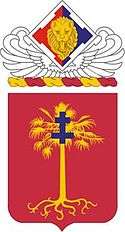 320th Field Artillery Regiment (Air Assault)
320th Field Artillery Regiment (Air Assault)
- 1st Battalion, 2d BCT, 101st Airborne Division (Air Assault), Fort Campbell, Kentucky
- 2d Battalion, 1st BCT, 101st Airborne Division (Air Assault), Fort Campbell, Kentucky
- 3d Battalion, 3d BCT, 101st Airborne Division (Air Assault), Fort Campbell, Kentucky
-
 321st Field Artillery Regiment
321st Field Artillery Regiment
- 1st Battalion (Abn), 18th Fires Brigade, XVIII Airborne Corps, Fort Bragg, North Carolina
- 3d Battalion, 18th Fires Brigade, XVIII Airborne Corps, Fort Bragg, North Carolina
-
 333d Field Artillery Regiment
333d Field Artillery Regiment
- Battery F (Target Acquisition), 210th Fires Brigade, 2d Infantry Division, South Korea
-
 377th Field Artillery Regiment
377th Field Artillery Regiment
- 1st Battalion, 17th Fires Brigade, I Corps, Fort Lewis, Washington
- 2d Battalion (Abn), 4th BCT, 25th Infantry Division, Fort Richardson, Alaska
Armored and Cavalry Regiments
 Armor
Armor
 34th Armored Regiment
34th Armored Regiment
- 2d Battalion, 1st BCT, 1st Infantry Division, Fort Riley, Kansas
 35th Armored Regiment
35th Armored Regiment
- 1st Battalion, 2d BCT, 1st Armored Division, Fort Bliss, Texas
-
 37th Armored Regiment
37th Armored Regiment
- 1st Battalion, 2d BCT, 1st Armored Division, Fort Bliss, Texas
 63d Armored Regiment
63d Armored Regiment
- 1st Battalion, 2d BCT, 1st Infantry Division, Fort Riley, Kansas
 64th Armored Regiment
64th Armored Regiment
- 1st Battalion, 2d BCT, 3d Infantry Division, Fort Stewart, Georgia
 66th Armored Regiment
66th Armored Regiment
- 1st Battalion, 3d BCT, 4th Infantry Division, Fort Carson, Colorado
- 3d Battalion, 1st BCT, 1st Infantry Division, Fort Riley, Kansas
 67th Armored Regiment
67th Armored Regiment
- 1st Battalion, 3d BCT, 1st Armored Division, Fort Bliss, Texas
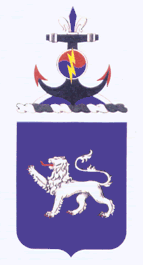 68th Armored Regiment
68th Armored Regiment
- 1st Battalion, 3d BCT, 4th Infantry Division, Fort Carson, Colorado
-
 69th Armored Regiment
69th Armored Regiment
- 2d Battalion, 3d BCT, 3d Infantry Division, Fort Benning, Georgia
- 3d Battalion, 1st BCT, 3d Infantry Division, Fort Stewart, Georgia
-
 70th Armored Regiment
70th Armored Regiment
- 2d Battalion, 2d BCT, 1st Infantry Division, Fort Riley, Kansas
 72d Armored Regiment
72d Armored Regiment
- No active Battalions
-
.gif) 77th Armored Regiment
77th Armored Regiment
- 1st Battalion, 4th BCT, 1st Armored Division, Fort Bliss, Texas
 81st Armored Regiment (Training Regiment)
81st Armored Regiment (Training Regiment)
- 1st Battalion, 194th Armored Brigade, Fort Benning, Georgia
- 2d Battalion, 194th Armored Brigade, Fort Benning, Georgia
- 3d Battalion, 194th Armored Brigade, Fort Benning, Georgia
 Cavalry
Cavalry
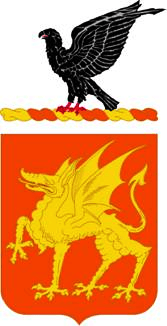 1st Cavalry Regiment
1st Cavalry Regiment
- 1st Squadron (Armored), 2d BCT, 1st Armored Division, Fort Bliss, Texas
- 3d Squadron (Light), 3d BCT, 3d Infantry Division, Fort Benning, Georgia
- 4th Squadron, United States Military Academy, West Point, New York
- 5th Squadron (Stryker), 1st BCT, 25th Infantry Division, Fort Wainwright, Alaska
- 6th Squadron (Stryker), 1st BCT, 1st Armored Division, Fort Bliss, Texas
- 8th Squadron (Stryker), 2d BCT, 2d Infantry Division, Fort Lewis, Washington
-
 2d Cavalry Regiment (Stryker Brigade Combat Team)
2d Cavalry Regiment (Stryker Brigade Combat Team)
- 1st Squadron (Stryker), 2d Cavalry Regiment, Vilseck, Germany
- 2d Squadron (Stryker), 2d Cavalry Regiment, Vilseck, Germany
- 3d Squadron (Stryker), 2d Cavalry Regiment, Vilseck, Germany
- 4th Squadron (Stryker), 2d Cavalry Regiment, Vilseck, Germany
- Fires Squadron, 2d Cavalry Regiment, Vilseck, Germany
- Engineer Squadron, 2d Cavalry Regiment, Grafenwoehr, Germany
- Support Squadron, 2d Cavalry Regiment, Vilseck, Germany
-
 3d Cavalry Regiment (Stryker Brigade Combat Team)
3d Cavalry Regiment (Stryker Brigade Combat Team)
- 1st Squadron (Stryker), 3d Cavalry Regiment, Fort Hood, Texas
- 2d Squadron (Stryker), 3d Cavalry Regiment, Fort Hood, Texas
- 3d Squadron (Stryker), 3d Cavalry Regiment, Fort Hood, Texas
- 4th Squadron (Stryker), 3d Cavalry Regiment, Fort Hood, Texas
- Fires Squadron, 3d Cavalry Regiment, Fort Hood, Texas
- Engineer Squadron, 3d Cavalry regiment, Fort Hood, Texas
- Support Squadron, 3d Cavalry Regiment, Fort Hood, Texas
-
 4th Cavalry Regiment
4th Cavalry Regiment
- 1st Squadron (Armored), 1st BCT, 1st Infantry Division, Fort Riley, Kansas
- 3d Squadron (Light), 3d BCT, 25th Infantry Division, Schofield Barracks, Hawaii
- 5th Squadron (Armored), 2d BCT, 1st Infantry Division, Fort Riley, Kansas
-
 5th Cavalry Regiment
5th Cavalry Regiment
- 1st Battalion (Combined Arms), 2d BCT, 1st Cavalry Division, Fort Hood, Texas
- 2d Battalion (Combined Arms), 1st BCT, 1st Cavalry Division, Fort Hood, Texas
-
6th Cavalry Regiment
- 1st Squadron, Combat Aviation Brigade, 1st Infantry Division, Fort Riley, Kansas
- 2d Squadron, Combat Aviation Brigade, 25th Infantry Division, Wheeler Army Air Field, Hawaii
- 4th Squadron, 16th Combat Aviation Brigade, Joint Base Lewis-McChord, Washington
- 6th Squadron, Combat Aviation Brigade, 10th Mountain Division (Light Infantry), Fort Drum, New York
-
 7th Cavalry Regiment
7th Cavalry Regiment
- 1st Squadron (Armored), 1st BCT, 1st Cavalry Division, Fort Hood, Texas
- 2d Battalion (Combined Arms), 3d BCT, 1st Cavalry Division, Fort Hood, Texas
- 3d Squadron (Light), 2d BCT, 3d Infantry Division, Fort Stewart, Georgia
- 5th Squadron (Armored), 1st BCT, 3d Infantry Division, Fort Stewart, Georgia
-
 8th Cavalry Regiment
8th Cavalry Regiment
- 1st Battalion (Combined Arms), 2d BCT, 1st Cavalry Division, Fort Hood, Texas
- 2d Battalion (Combined Arms), 1st BCT, 1st Cavalry Division, Fort Hood, Texas
- 3d Battalion (Combined Arms), 3d BCT, 1st Cavalry Division, Fort Hood, Texas
-
 9th Cavalry Regiment
9th Cavalry Regiment
- 1st Battalion (Combined Arms), 2d BCT, 1st Cavalry Division, Fort Hood, Texas
- 4th Squadron (Armored), 2d BCT, 1st Cavalry Division, Fort Hood, Texas
- 6th Squadron (Armored), 3d BCT, 1st Cavalry Division, Fort Hood, Texas
-
 10th Cavalry Regiment
10th Cavalry Regiment
- 2d Squadron (Stryker), 1st BCT, 4th Infantry Division, Fort Carson, Colorado
- 4th Squadron (Armored), 3d BCT, 4th Infantry Division, Fort Carson, Colorado
-
 11th Armored Cavalry Regiment
11th Armored Cavalry Regiment
- 1st Squadron (OPFOR), Fort Irwin, California
- 2d Squadron (OPFOR), Fort Irwin, California
- Regimental Support Squadron, Fort Irwin, California
-
12th Cavalry Regiment
- 1st Battalion (Combined Arms), 3d BCT, 1st Cavalry Division, Fort Hood, Texas
- 2d Battalion (Combined Arms), 1st BCT, 1st Cavalry Division, Fort Hood, Texas
-
 13th Cavalry Regiment
13th Cavalry Regiment
- 2d Squadron (Armored), 3d BCT, 1st Armored Division, Fort Bliss, Texas
-
 14th Cavalry Regiment
14th Cavalry Regiment
- 1st Squadron (Stryker), 3d BCT, 2d Infantry Division, Fort Lewis, Washington
- 2d Squadron (Light), 2d BCT, 25th Infantry Division, Schofield Barracks, Hawaii
-
 15th Cavalry Regiment (Training Regiment)
15th Cavalry Regiment (Training Regiment)
- 5th Battalion (OSUT), 194th Armored Brigade, Fort Benning, Georgia
-
 16th Cavalry Regiment (Training Regiment)
16th Cavalry Regiment (Training Regiment)
- 1st Squadron, 316th Cavalry Brigade, Fort Benning, Georgia
- 2d Squadron, 316th Cavalry Brigade, Fort Benning, Georgia
- 3d Squadron, 316th Cavalry Brigade, Fort Benning, Georgia
-
 17th Cavalry Regiment
17th Cavalry Regiment
- 1st Squadron, Combat Aviation Brigade, 82d Airborne Division, Fort Bragg, North Carolina
- 2d Squadron, 101st Combat Aviation Brigade, 101st Airborne Division (Air Assault), Fort Campbell, Kentucky
- 3d Squadron, Combat Aviation Brigade, 3d Infantry Division, Fort Stewart, Georgia
- 6th Squadron, 16th Combat Aviation Brigade, I Corps, Joint Base Lewis-McChord, Washington
- 7th Squadron, 159th Combat Aviation Brigade, 101st Airborne Division (Air Assault), Fort Campbell, Kentucky
 32d Cavalry Regiment
32d Cavalry Regiment
- 1st Squadron (Light), 1st BCT, 101st Airborne Division (Air Assault), Fort Campbell, Kentucky
 33d Cavalry Regiment
33d Cavalry Regiment
- 1st Squadron (Light), 3d BCT, 101st Airborne Division (Air Assault), Fort Campbell, Kentucky
-
 38th Cavalry Regiment
38th Cavalry Regiment
- 1st Squadron (Light), 525th Battlefield Surveillance Brigade, Fort Bragg, North Carolina
- 2d Squadron (Light), 504th Battlefield Surveillance Brigade, Fort Hood, Texas
- 3d Squadron (Light), 201st Battlefield Surveillance Brigade, Joint Base Lewis-McChord, Washington
 40th Cavalry Regiment
40th Cavalry Regiment
- 1st Squadron (Light), 4th BCT (ABN), 25th Infantry Division, Fort Richardson, Alaska
-
 61st Cavalry Regiment
61st Cavalry Regiment
- 3d Squadron (Light), 2d BCT, 4th Infantry Division, Fort Carson, Colorado
-
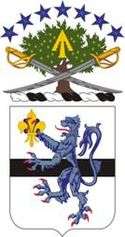 71st Cavalry Regiment
71st Cavalry Regiment
- 1st Squadron (Light), 1st BCT, 10th Mountain Division (Light Infantry), Fort Drum, New York
-
 73rd Cavalry Regiment
73rd Cavalry Regiment
- 1st Squadron (Light), 2d BCT, 82d Airborne Division, Fort Bragg, North Carolina
- 3d Squadron (Light), 1st BCT, 82d Airborne Division, Fort Bragg, North Carolina
- 5th Squadron (Light), 3d BCT, 82d Airborne Division, Fort Bragg, North Carolina
-
 75th Cavalry Regiment
75th Cavalry Regiment
- 1st Squadron (Light), 2d BCT, 101st Airborne Division (Air Assault), Fort Campbell, Kentucky
-
 89th Cavalry Regiment
89th Cavalry Regiment
- 1st Squadron (Light), 2d BCT, 10th Mountain Division (Light Infantry), Fort Drum, New York
- 3d Squadron (Light), 4th BCT, 10th Mountain Division (Light Infantry), Fort Polk, Louisiana
-
 91st Cavalry Regiment
91st Cavalry Regiment
- 1st Squadron (Light), 173d BCT (ABN), Grafenwoehr, Germany
 Aviation Regiments
Aviation Regiments
-
 1st Aviation Regiment
1st Aviation Regiment
- 1st Battalion, Combat Aviation Brigade, 1st Infantry Division, Fort Riley, Kansas
- 2d Battalion, Combat Aviation Brigade, 1st Infantry Division, Fort Riley, Kansas
- 3d Battalion, Combat Aviation Brigade, 1st Infantry Division, Fort Riley, Kansas
-
 2d Aviation Regiment
2d Aviation Regiment
- 2d Battalion (Assault), Combat Aviation Brigade, 2d Infantry Division, K-16 Air Base, Seongnam, South Korea
- 3d Battalion (General Support), Combat Aviation Brigade, 2d Infantry Division, Camp Humphreys, Pyeongtaek, South Korea
- 4th Battalion (Attack), Combat Aviation Brigade, 2d Infantry Division, Camp Humphreys, Pyeongtaek, South Korea
-
 3d Aviation Regiment
3d Aviation Regiment
- 1st Battalion, Combat Aviation Brigade, 3d Infantry Division, Fort Stewart, Georgia
- 2d Battalion, Combat Aviation Brigade, 3d Infantry Division, Fort Stewart, Georgia
- 4th Battalion, Combat Aviation Brigade, 3d Infantry Division, Fort Stewart, Georgia
-
 4th Aviation Regiment
4th Aviation Regiment
- 1st Battalion, Combat Aviation Brigade, 4th Infantry Division, Fort Hood, Texas
- 2d Battalion, Combat Aviation Brigade, 4th Infantry Division, Fort Hood, Texas
- 3d Battalion, Combat Aviation Brigade, 4th Infantry Division, Fort Hood, Texas
- 4th Battalion, Combat Aviation Brigade, 4th Infantry Division, Fort Hood, Texas
-
 10th Aviation Regiment
10th Aviation Regiment
- 1st Battalion, Combat Aviation Brigade, 10th Mountain Division (Light Infantry), Fort Drum, New York
- 2d Battalion, Combat Aviation Brigade, 10th Mountain Division (Light Infantry), Fort Drum, New York
- 3d Battalion, Combat Aviation Brigade, 10th Mountain Division (Light Infantry), Fort Drum, New York
-
 11th Aviation Regiment (Training)
11th Aviation Regiment (Training)
- 1st Battalion, 110th Aviation Brigade, Fort Rucker, Alabama
-
 13th Aviation Regiment (Training)
13th Aviation Regiment (Training)
- 1st Battalion, 1st Aviation Brigade, Fort Rucker, Alabama
- 2d Battalion, 1st Aviation Brigade, Fort Rucker, Alabama
-
 14th Aviation Regiment (Training Regiment)
14th Aviation Regiment (Training Regiment)
- 1st Battalion, 110th Aviation Brigade, Fort Rucker, Alabama
-
 25th Aviation Regiment
25th Aviation Regiment
- 1d Battalion, Combat Aviation Brigade, 25th Infantry Division, Fort Carson, Colorado
- 2d Battalion, Combat Aviation Brigade, 25th Infantry Division, Wheeler Field, Hawaii
- 3d Battalion, Combat Aviation Brigade, 25th Infantry Division, Wheeler Field, Hawaii
- Company C, Combat Aviation Brigade, 25th Infantry Division, Wheeler Field, Hawaii
-
 52d Aviation Regiment
52d Aviation Regiment
- 1st Battalion, 16th Combat Aviation Brigade, Fort Wainwright, Alaska
- 2d Battalion, Combat Aviation Brigade, 2d Infantry Division, Camp Humphreys, South Korea
- 6th Battalion, 11th Aviation Command, Los Alamitos, California
- Company G, 12th Combat Aviation Brigade, U.S. Army Europe, Germany
-
 58th Aviation Regiment
58th Aviation Regiment
- 1st Battalion, Fort Rucker, Alabama
- 3d Battalion, 12th Combat Aviation Brigade, U.S. Army Europe, Germany
-
 82d Aviation Regiment
82d Aviation Regiment
- 1st Battalion, Combat Aviation Brigade, 82d Airborne Division, Fort Bragg, North Carolina
- 2d Battalion, Combat Aviation Brigade, 82d Airborne Division, Fort Bragg, North Carolina
- 3d Battalion, Combat Aviation Brigade, 82d Airborne Division, Fort Bragg, North Carolina
-
 101st Aviation Regiment
101st Aviation Regiment
- 1st Battalion, 101st Combat Aviation Brigade, 101st Airborne Division (Air Assault), Fort Campbell, Kentucky
- 5th Battalion, 101st Combat Aviation Brigade, 101st Airborne Division (Air Assault), Fort Campbell, Kentucky
- 6th Battalion, 101st Combat Aviation Brigade, 101st Airborne Division (Air Assault), Fort Campbell, Kentucky
-
 111th Aviation Regiment (FLARNG)
111th Aviation Regiment (FLARNG)
- 1st Battalion, Combat Aviation Brigade, 28th Infantry Division, Jacksonville, Florida
-
 145th Aviation Regiment (Training)
145th Aviation Regiment (Training)
- 1st Battalion, 1st Aviation Brigade, Fort Rucker, Alabama
-
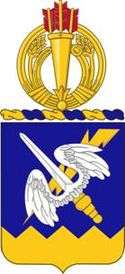 158th Aviation Regiment
158th Aviation Regiment
- 1st Battalion, 11th Aviation Command, Conroe, Texas
- 3d Battalion, 12th Combat Aviation, Brigade, Germany
- 5th Battalion, 12th Combat Aviation Brigade, Germany
- 7th Battalion, 244th Aviation Brigade, Fort Hood, Texas (USAR)
- Company I, Fort Hood, Texas
-
 159th Aviation Regiment
159th Aviation Regiment
- 2d Battalion, 12th Combat Aviation Brigade, Germany
- 3d Battalion, 12th Combat Aviation Brigade, Germany
- 5th Battalion, 244th Aviation Brigade, Fort Eustis, Virginia
-
 160th Aviation Regiment (Special Operations)
160th Aviation Regiment (Special Operations)
- 1st Battalion, Fort Campbell, Kentucky
- 2d Battalion, Fort Campbell, Kentucky
- 3d Battalion, Hunter Army Airfield, Georgia
- 4th Battalion, Fort Lewis, Washington
-
 210th Aviation Regiment (Training)
210th Aviation Regiment (Training)
- 1st Battalion, 128th Aviation Brigade, Fort Rucker, Alabama
- 2d Battalion, 128th Aviation Brigade, Fort Rucker, Alabama
-
 212th Aviation Regiment (Training)
212th Aviation Regiment (Training)
- 1st Battalion, 110th Aviation Brigade, Fort Rucker, Alabama
-
 214th Aviation Regiment
214th Aviation Regiment
- 1st Battalion, 12th Combat Aviation Brigade, Germany
- 222d Aviation Regiment
- 1st Battalion, 128th Aviation Brigade, Fort Rucker, Alabama
-
 223d Aviation Regiment (Training)
223d Aviation Regiment (Training)
- 1st Battalion, 110th Aviation Brigade, Fort Rucker, Alabama
-
 227th Aviation Regiment
227th Aviation Regiment
- 1st Battalion, Combat Aviation Brigade, 1st Cavalry Division, Fort Hood, Texas
- 2d Battalion, Combat Aviation Brigade, 1st Cavalry Division, Fort Hood, Texas
- 3d Battalion, Combat Aviation Brigade, 1st Cavalry Division, Fort Hood, Texas
- 4th Battalion, Combat Aviation Brigade, 1st Cavalry Division, Fort Hood, Texas
-
 228th Aviation Regiment
228th Aviation Regiment
- 1st Battalion, Joint Task Force Bravo, Soto Cano Air Base, Honduras
- 2d Battalion, 244th Aviation Brigade, Horsham, Pennsylvania (USAR)
-
 229th Aviation Regiment
229th Aviation Regiment
- 1st Battalion, 16th Combat Aviation Brigade (United_States), Fort Lewis, Washington
- 8th Battalion, 11th Theater Aviation Command (United States), Fort Knox, Kentucky
-
 501st Aviation Regiment
501st Aviation Regiment
- 1st Battalion, Combat Aviation Brigade, 1st Armored Division (United_States), Ft. Bliss, Texas
- 2d Battalion, Combat Aviation Brigade, 1st Armored Division (United_States), Ft. Bliss, Texas
- 3d Battalion, Combat Aviation Brigade, 1st Armored Division (United_States), Ft. Bliss, Texas
- 4th Battalion, Combat Aviation Brigade, 1st Armored Division (United_States), Ft. Bliss, Texas
 Infantry Regiments
Infantry Regiments
Light, Stryker and Mechanized Infantry
- 1st Infantry
- 1st Battalion (Garrison), United States Military Academy, West Point, New York
- 2d Battalion (Stryker), 2d BCT, 2d Infantry Division, Fort Lewis, Washington
-
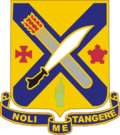 2d Infantry Regiment
2d Infantry Regiment
- No active battalions
-
 3rd Infantry Regiment
3rd Infantry Regiment
- 1st Battalion, Military District of Washington, Fort Myer, Virginia
- 2d Battalion, 3d BCT, 2d Infantry Division, Fort Lewis, Washington
- 4th Battalion, Military District of Washington, Fort Myer, Virginia
-
4th Infantry Regiment
- 1st Battalion (OPFOR), Joint Multinational Training Center, Seventh U.S. Army, Hohenfels, Germany
- 2d Battalion (Light), 4th BCT, 10th Mountain Division (Light Infantry), Fort Polk, Louisiana
-
 5th Infantry Regiment
5th Infantry Regiment
- 1st Battalion (Stryker), 1st BCT, 25th Infantry Division, Fort Wainwright, Alaska
- 2d Battalion (Combined Arms), 3d BCT Brigade, 1st Armored Division, Fort Bliss, Texas
-
 6th Infantry Regiment
6th Infantry Regiment
- 1st Battalion (Combined Arms), 2d BCT, 1st Armored Division, Fort Bliss, Texas
-
 7th Infantry Regiment
7th Infantry Regiment
- 2d Battalion (Combined Arms), 1st BCT, 3d Infantry Division, Fort Stewart, Georgia
-
 8th Infantry Regiment
8th Infantry Regiment
- 1st Battalion (Combined Arms), 3d BCT, 4th Infantry Division, Fort Carson, Colorado
-
 9th Infantry Regiment
9th Infantry Regiment
- 4th Battalion (Stryker), 1st BCT, 4th Infantry Division, Fort Carson, Colorado
-
 10th Infantry Regiment (Training Regiment)
10th Infantry Regiment (Training Regiment)
- 2d Battalion, 3d Chemical Brigade, Fort Leonard Wood, Missouri
- 3d Battalion, 3d Chemical Brigade, Fort Leonard Wood, Missouri
- 4th Battalion, 171st Infantry Brigade, Fort Jackson, South Carolina
-
 11th Infantry Regiment (Training Regiment)
11th Infantry Regiment (Training Regiment)
- 1st Battalion, 199th Infantry Brigade (Basic Officer Leader Course), Fort Benning, Georgia
- 2d Battalion, 199th Infantry Brigade (Infantry Officer Basic Course), Fort Benning, Georgia
- 3d Battalion, 199th Infantry Brigade (United States Army OCS), Fort Benning, Georgia
-
 12th Infantry Regiment
12th Infantry Regiment
- 1st Battalion (Light), 2d BCT, 4th Infantry Division, Fort Carson, Colorado
- 2d Battalion (Light), 2d BCT, 4th Infantry Division, Fort Carson, Colorado
-
 13th Infantry Regiment (Training Regiment)
13th Infantry Regiment (Training Regiment)
- 1st Battalion, 193d Infantry Brigade, Fort Jackson, South Carolina
- 2d Battalion, 193d Infantry Brigade, Fort Jackson, South Carolina
- 3d Battalion, 193d Infantry Brigade, Fort Jackson, South Carolina
-
 14th Infantry Regiment
14th Infantry Regiment
- 1st Battalion (Light), 2d BCT, 25th Infantry Division, Schofield Barracks, Hawaii
- 2d Battalion (Light), 2d BCT, 10th Mountain Division (Light Infantry), Fort Drum, New York
-
 15th Infantry Regiment
15th Infantry Regiment
- 1st Battalion (Light), 3d BCT, 3d Infantry Division, Fort Benning, Georgia
-
 16th Infantry Regiment
16th Infantry Regiment
- 1st Battalion (Combined Arms), 1st BCT, 1st Infantry Division, Fort Riley, Kansas
-
 17th Infantry Regiment
17th Infantry Regiment
- 1st Battalion (Stryker), 2d BCT, 2d Infantry Division, Fort Lewis, Washington
- 4th Battalion (Stryker), 1st BCT, 1st Armored Division, Fort Bliss, Texas
-
 18th Infantry Regiment
18th Infantry Regiment
- 1st Battalion (Combined Arms), 2d BCT, 1st Infantry Division, Fort Riley, Kansas
-
 19th Infantry Regiment (Training Regiment)
19th Infantry Regiment (Training Regiment)
- 1st Battalion, 198th Infantry Brigade, Fort Benning, Georgia
- 2d Battalion, 198th Infantry Brigade, Fort Benning, Georgia
-
 20th Infantry Regiment
20th Infantry Regiment
- 5th Battalion (Stryker), 3d BCT, 2d Infantry Division, Fort Lewis, Washington
-
 21st Infantry Regiment
21st Infantry Regiment
- 1st Battalion (Light), 2d BCT, 25th Infantry Division, Schofield Barracks, Hawaii
- 3d Battalion (Stryker), 1st BCT, 25th Infantry Division, Fort Wainwright, Alaska
-
22nd Infantry Regiment
- 1st Battalion, 1st BCT, 4th Infantry Division, Fort Carson, Colorado
- 2d Battalion, 1st BCT, 10th Mountain Division (Light Infantry), Fort Drum, New York
-
 23rd Infantry Regiment
23rd Infantry Regiment
- 1st Battalion, 3d BCT, 2d Infantry Division, Fort Lewis, Washington
- 2d Battalion, 4th BCT, 2d Infantry Division, Fort Lewis, Washington
- 4th Battalion, 2d BCT, 2d Infantry Division, Fort Lewis, Washington
-
 24th Infantry Regiment
24th Infantry Regiment
- 1st Battalion, 1st BCT, 25th Infantry Division, Fort Wainwright, Alaska
-
 27th Infantry Regiment
27th Infantry Regiment
- 1st Battalion, 2d BCT, 25th Infantry Division, Schofield Barracks, Hawaii
- 2d Battalion, 3d BCT, 25th Infantry Division, Schofield Barracks, Hawaii
-
 28th Infantry Regiment
28th Infantry Regiment
- 1st Battalion, 4th BCT, 1st Infantry Division, Fort Riley, Kansas
-
 29th Infantry Regiment (Training Regiment)
29th Infantry Regiment (Training Regiment)
- 1st Battalion, 197th Infantry Brigade, Fort Benning, Georgia
- 2d Battalion, 197th Infantry Brigade, Fort Benning, Georgia
-
 30th Infantry Regiment
30th Infantry Regiment
- 1st Battalion, 2d BCT, 3d Infantry Division, Fort Stewart, Georgia
- 2d Battalion, 4th BCT, 10th Mountain Division (Light Infantry), Fort Polk, Louisiana
-
 31st Infantry Regiment
31st Infantry Regiment
- 4th Battalion, 2d BCT, 10th Mountain Division (Light Infantry), Fort Drum, New York
-
 32nd Infantry Regiment
32nd Infantry Regiment
- 1st Battalion, 3d BCT, 10th Mountain Division (Light Infantry), Fort Drum, New York
-
 34th Infantry Regiment(Training Regiment)
34th Infantry Regiment(Training Regiment)
- 1st Battalion, 165th Infantry Brigade, Fort Jackson, South Carolina
- 3d Battalion, 165th Infantry Brigade, Fort Jackson, South Carolina
- 35th Infantry Regiment
- 2d Battalion, 3d BCT, 25th Infantry Division, Schofield Barracks, Hawaii
-
 36th Infantry Regiment
36th Infantry Regiment
- 1st Battalion, 1st BCT, 1st Armored Division, Fort Bliss, Texas
-
 38th Infantry Regiment
38th Infantry Regiment
- 1st Battalion, 4th BCT, 2d Infantry Division, Fort Lewis, Washington
- 39th Infantry Regiment (United States) (Training Regiment)
- 2d Battalion, 165th Infantry Brigade, Fort Jackson, South Carolina
-
 41st Infantry Regiment
41st Infantry Regiment
- 1st Battalion, 3d BCT, 1st Armored Division, Fort Bliss, Texas
- 3d Battalion, 1st BCT, 1st Armored Division, Fort Bliss, Texas
-
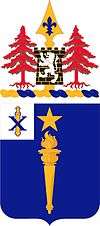 46th Infantry Regiment (Training Regiment)
46th Infantry Regiment (Training Regiment)
- 1st Battalion, 194th Armored Brigade, Fort Benning, Georgia
- 2d Battalion, 194th Armored Brigade, Fort Benning, Georgia
-
 47th Infantry Regiment (Training Regiment)
47th Infantry Regiment (Training Regiment)
- 2d Battalion, 192d Infantry Brigade, Fort Benning, Georgia
- 3d Battalion, 192d Infantry Brigade, Fort Benning, Georgia
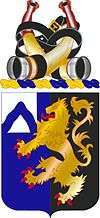 48th Infantry Regiment (Training Regiment)
48th Infantry Regiment (Training Regiment)
- 1st Battalion, 3d Chemical Brigade, Fort Leonard Wood, Missouri
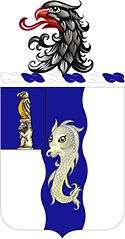 50th Infantry Regiment (Training Regiment)
50th Infantry Regiment (Training Regiment)
- 1st Battalion, 198th Infantry Brigade, Fort Benning, Georgia
-
 51st Infantry Regiment
51st Infantry Regiment
- Company F, 1st BCT, 1st Armored Division, Fort Bliss, Texas
-
 52nd Infantry Regiment
52nd Infantry Regiment
- Company A, 2d BCT, 2d Infantry Division, Fort Lewis, Washington
- Company B, 2d BCT, 25th Infantry Division, Schofield Barracks, Hawaii
- Company C, 3d BCT, 2d Infantry Division, Fort Lewis, Washington
- Company D, 1st BCT, 25th Infantry Division, Fort Wainwright, Alaska
- Company F, 4th BCT, 2d Infantry Division, Fort Lewis, Washington
 54th Infantry Regiment (Training Regiment)
54th Infantry Regiment (Training Regiment)
- 2d Battalion, 192d Infantry Brigade, Fort Benning, Georgia
-
 58th Infantry Regiment (Training Regiment)
58th Infantry Regiment (Training Regiment)
- 2d Battalion, 198th Infantry Brigade, Fort Benning, Georgia
-
 60th Infantry Regiment (Training Regiment)
60th Infantry Regiment (Training Regiment)
- 2d Battalion, 193d Infantry Brigade, Fort Jackson, South Carolina
- 3d Battalion, 193d Infantry Brigade, Fort Jackson, South Carolina
-
 61st Infantry Regiment (Training Regiment)
61st Infantry Regiment (Training Regiment)
- 1st Battalion, 165th Infantry Brigade, Fort Jackson, South Carolina
-
 87th Infantry Regiment
87th Infantry Regiment
- 1st Battalion, 1st BCT, 10th Mountain Division (Light Infantry), Fort Drum, New York
- 2d Battalion, 3d BCT, 10th Mountain Division (Light Infantry), Fort Drum, New York
Airborne and Air Assault Infantry
-
 26th Infantry Regiment (Air Assault)
26th Infantry Regiment (Air Assault)
- 1st Battalion, 2d BCT, 101st Airborne Division (Air Assault), Fort Campbell, Kentucky
-
 187th Infantry Regiment (Air Assault)
187th Infantry Regiment (Air Assault)
- 1st Battalion, 3d BCT, 101st Airborne Division (Air Assault), Fort Campbell, Kentucky
- 3d Battalion, 3d BCT, 101st Airborne Division (Air Assault), Fort Campbell, Kentucky
-
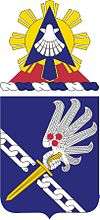 188th Infantry Regiment (Airborne)(Inactive)
188th Infantry Regiment (Airborne)(Inactive) -
 325th Infantry Regiment (Airborne)
325th Infantry Regiment (Airborne)
- 1st Battalion, 2d BCT, 82d Airborne Division, Fort Bragg, North Carolina
- 2d Battalion, 2d BCT, 82d Airborne Division, Fort Bragg, North Carolina
-
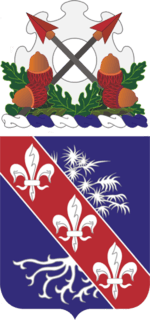 327th Infantry Regiment (Air Assault)
327th Infantry Regiment (Air Assault)
- 1st Battalion, 1st BCT, 101st Airborne Division (Air Assault), Fort Campbell, Kentucky
- 2d Battalion, 1st BCT, 101st Airborne Division (Air Assault), Fort Campbell, Kentucky
-
 501st Infantry Regiment (Airborne)
501st Infantry Regiment (Airborne)
- 1st Battalion, 4th BCT, 25th Infantry Division, Fort Richardson, Alaska
- 2d Battalion, 1st BCT, 82d Airborne Division, Fort Bragg, North Carolina
-
502d Infantry Regiment (Air Assault)
- 1st Battalion, 2d BCT, 101st Airborne Division (Air Assault), Fort Campbell, Kentucky
- 2d Battalion, 2d BCT, 101st Airborne Division (Air Assault), Fort Campbell, Kentucky
-
 503d Infantry Regiment (Airborne)
503d Infantry Regiment (Airborne)
- 1st Battalion, 173d ABCT, Vicenza, Italy
- 2n Battalion, 173d ABCT, Vicenza, Italy
-
504th Infantry Regiment (Airborne)
- 1st Battalion, 1st BCT, 82d Airborne Division, Fort Bragg, North Carolina
- 2d Battalion, 1st BCT, 82d Airborne Division, Fort Bragg, North Carolina
-
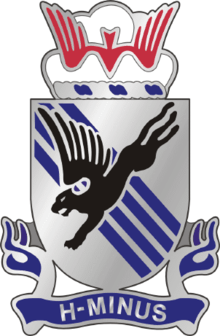 505th Infantry Regiment (Airborne)
505th Infantry Regiment (Airborne)
- 1st Battalion, 3d BCT, 82d Airborne Division, Fort Bragg, North Carolina
- 2d Battalion, 3d BCT, 82d Airborne Division, Fort Bragg, North Carolina
-
.svg.png) 506th Infantry Regiment (Air Assault)
506th Infantry Regiment (Air Assault)
- 1st Battalion, 1st BCT, 101st Airborne Division (Air Assault), Fort Campbell, Kentucky
- 2d Battalion, 3rd BCT, 101st Airborne Division (Air Assault), Fort Campbell, Kentucky
- 507th Infantry Regiment (Airborne)(Training Regiment)
- 1st Battalion, Airborne and Ranger Training Brigade, Fort Benning, Georgia
-
 508th Infantry Regiment (Airborne)
508th Infantry Regiment (Airborne)
- 1st Battalion, 3d BCT, 82d Airborne Division, Fort Bragg, North Carolina
- 2d Battalion, 2d BCT, 82d Airborne Division, Fort Bragg, North Carolina
-
 509th Infantry Regiment (Airborne)
509th Infantry Regiment (Airborne)
- 1st Battalion, JRTC, Fort Polk, Louisiana (Operates as an Opposing Force for training)
- 3d Battalion, 4th BCT, 25th Infantry Division, Fort Richardson, Alaska
-
 511th Infantry Regiment (Airborne)(Inactive)
511th Infantry Regiment (Airborne)(Inactive)
Ranger Infantry
-
 75th Ranger Regiment
75th Ranger Regiment
- 1st Battalion, Hunter Army Airfield, Georgia
- 2d Battalion, Fort Lewis, Washington
- 3d Battalion, Fort Benning, Georgia
- Special Troops Battalion, Fort Benning, Georgia
 Special Forces
Special Forces
 1st Special Forces/Special Forces Command
1st Special Forces/Special Forces Command
- 1st Special Forces Group (Airborne)
- 1st Battalion, Okinawa, Japan
- 2d Battalion, Fort Lewis, Washington
- 3d Battalion, Fort Lewis, Washington
- 4th Battalion, Fort Lewis, Washington
- Support Battalion, Fort Lewis, Washington
- 3d Special Forces Group (Airborne)
- 1st Battalion, Fort Bragg, North Carolina
- 2d Battalion, Fort Bragg, North Carolina
- 3d Battalion, Fort Bragg, North Carolina
- 4th Battalion, Fort Bragg, North Carolina
- Support Battalion, Fort Bragg, North Carolina
- 5th Special Forces Group (Airborne)
- 1st Battalion, Fort Campbell, Kentucky
- 2d Battalion, Fort Campbell, Kentucky
- 3d Battalion, Fort Campbell, Kentucky
- 4th Battalion, Fort Campbell, Kentucky
- Support Battalion, Fort Campbell, Kentucky
- 7th Special Forces Group (Airborne)
- 1st Battalion, Eglin AFB, Florida
- 2d Battalion, Eglin AFB, Florida
- 3d Battalion, Eglin AFB, Florida
- 4th Battalion, Eglin AFB, Florida
- Support Battalion, Eglin AFB, Florida
- 10th Special Forces Group (Airborne)
- 1st Battalion, Stuttgart, Germany
- 2d Battalion, Fort Carson, Colorado
- 3d Battalion, Fort Carson, Colorado
- 4th Battalion, Fort Carson, Colorado
- Support Battalion, Fort Carson, Colorado
- 19th Special Forces Group (Airborne) (Army National Guard)
- 1st Battalion (WAARNG, UTARNG)
- 2d Battalion (OHARNG, RIARNG, WVARNG)
- 5th Battalion (COARNG)
- 20th Special Forces Group (Airborne) (Army National Guard)
- 1st Battalion (ALARNG, MAARNG)
- 2d Battalion (ILARNG, MDARNG, MSARNG)
- 3d Battalion (FLARNG, NCARNG)
Combat Support (CS), Combat Service Support (CSS), and Special Branches
Concept
The CS, CSS, and special branch regimental plans fully integrate the CS, CSS, and special branches into the USARS under the “whole branch” concept. It is the responsibility of all proponents to incorporate within their corps, the intent and spirit of the regimental system to provide soldiers the opportunity for affiliation.
While this initiative mandates a uniform approach to regimental affiliation throughout the Army, it is a system that has no tradition within the Army and duplicates the sense of affiliation that CS, CSS, and special branch soldiers already had for their branch (Ordnance, Signal Corps, etc.)
Branches within the CS, CSS, and Special Branches Regimental System
-

Psychological Operations (2007)
-

Acquisition Corps (2008)
References
- Army Regulation 600-82, U.S. Army Regimental System, 5 June 1990. Accessed 23 October 2016.




